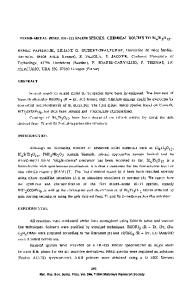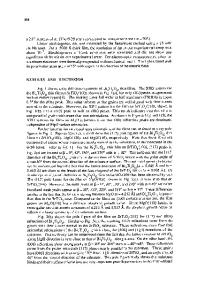Fabrication of V-Substituted (Bi, M) 4 Ti 3 O 12 [M = Lanthanoids] Thin Films by Chemical Solution Deposition Method
- PDF / 1,108,558 Bytes
- 6 Pages / 612 x 792 pts (letter) Page_size
- 91 Downloads / 355 Views
Fabrication of V-Substituted (Bi,M)4Ti3O12 [M = Lanthanoids] Thin Films by Chemical Solution Deposition Method H. Uchida1, H. Yoshikawa1, I. Okada1, H. Matsuda2, T. Iijima2, T. Watanabe3 and H. Funakubo3 1 Department of Chemistry, Faculty of Science and Engineering, Sophia University, 7-1 Kioi-cho, Chiyoda-ku, Tokyo, 102-8554, Japan 2 Smart Structure Research Center, National Institute of Advanced Industrial Science and Technology (AIST), 1-1-1 Umezono, Tsukuba, 305-8568, Japan 3 Department of Innovative and Engineered Materials, Tokyo Institute of Technology, 4259 Nagatsuta, Midori-ku, Yokohama, 226-8502, Japan ABSTRACT Bismuth titanate (Bi4Ti3O12; BIT) -based ferroelectric materials are proposed from the view of the “Site-engineering”, where the Bi-site ions are substituted by lanthanoid ions (La3+ and Nd3+) and Ti-site ions by other ions with higher charge valence (V5+). In the present study, influences of vanadium (V) - substitution for (Bi,M)4Ti3O12 thin films [M = lanthanoid] on the ferroelectric properties are evaluated. V-substituted (Bi,M)4Ti3O12 films have been fabricated using a chemical solution deposition (CSD) technique on the (111)Pt/Ti/SiO2/(100)Si substrate. Remnant polarization of (Bi,La)4Ti3O12 and (Bi,Nd)4Ti3O12 films has been improved by the V-substitution independent of the coercive field. The processing temperature of BLT and BNT films could also be lowered by the V-substitution. INTRODUCTION Recently, extensive research on ferroelectric thin films has been reported for application of non-volatile random access memories (NvRAMs). Memory capacitors in NvRAMs mainly consist of the ferroelectric films that store the charge signals (“0” or “1”) by the ferroelectric polarization. We strongly desire improvement of the memory density in NvRAM, which may be achieved by the circuit integration of the memory devices. In order to proceed the further integration of NvRAM circuit, ferroelectric thin films with higher remnant polarization (Pr), lower coercive field (Ec) and fatigue-free property during the cyclic switching of dielectric polarization are required. Bismuth layer-structured ferroelectrics (BLSFs), including SrBi2Ta2O9 (SBT; m = 2) and Bi4Ti3O12 (BIT; m = 3), are attractive materials because of their fatigue endurance, quick response of polarization switching and lead (Pb) -free chemical compositions. Much attention is paid particularly to BIT among BLSFs as an alternative material of the present Pb-based ferroelectrics for application of NvRAMs, because BIT has lower processing temperature than other BLSFs have [1]. However, BLSFs at present are not suited for the materials of NvRAM capacitors because Pr of BLSFs is quite lower than those of Pb-based ferroelectrics like lead titanate PbTiO3 (PT) and lead zirconate-titanate Pb(Zr,Ti)O3 (PZT); e.g., polycrystalline BIT films have Pr values lower than 10 µC/cm2, although spontaneous polarizations (Ps) of BIT single crystal along c- and a-axes are estimated approximately to be 4 and 50 µC/cm2 respectively, which are smaller than those of Pb-based
Data Loading...











